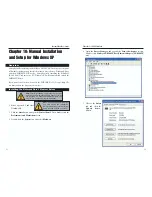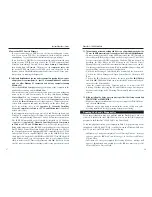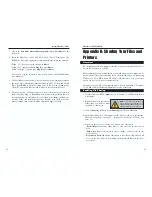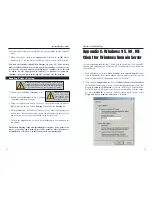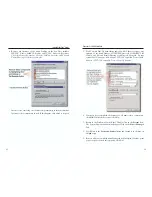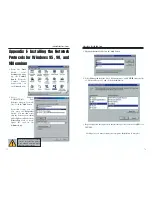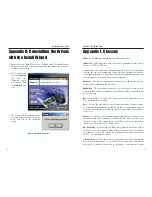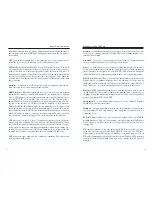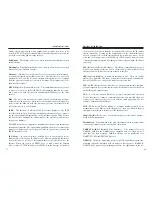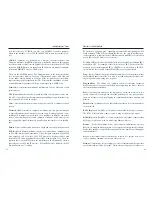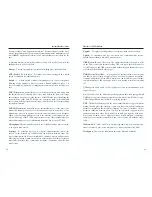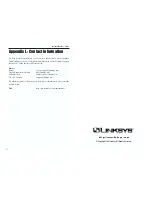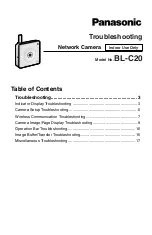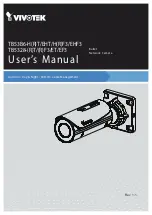
Domain
- A subnetwork comprised of a group of clients and servers under the
control of one security database. Dividing LANs into domains improves per-
formance and security.
Download
- To receive a file transmitted over a network. In a communications
session, download means receive, upload means transmit.
Driver
- A workstation or server software module that provides an interface
between a network interface card and the upper-layer protocol software running
in the computer; it is designed for a specific NIC, and is installed during the
initial installation of a network-compatible client or server operating system.
DSL
(
D
igital
S
ubscriber
L
ine) - A technology that dramatically increases the
digital capacity of ordinary telephone lines into the home or office and, by
employing unused bandwidth, still allows for normal phone usage. DSL pro-
vides "always-on" operation, eliminating the need to dial in to the service.
Ethernet
- IEEE standard network protocol that specifies how data is placed
on and retrieved from a common transmission medium. Has a transfer rate of
10 Mbps. Forms the underlying transport vehicle used by several upper-level
protocols, including TCP/IP and XNS.
Fast Ethernet
- A 100 Mbps technology based on the 10Base-T Ethernet
CSMA/CD network access method.
Firmware
- Programming that is inserted into programmable read-only mem-
ory (programmable read-only memory), thus becoming a permanent part of a
computing device.
FTP
(
F
ile
T
ransfer
P
rotocol) - A protocol used to transfer files over a TCP/IP
network (Internet, UNIX, etc.). For example, after developing the HTML pages
for a Web site on a local machine, they are typically uploaded to the Web serv-
er using FTP.
FTP includes functions to log onto the network, list directories and copy files.
It can also convert between the ASCII and EBCDIC character codes. FTP oper-
ations can be performed by typing commands at a command prompt or via an
FTP utility running under a graphical interface such as Windows. FTP transfers
can also be initiated from within a Web browser by entering the URL preceded
with ftp://.
(WKHU)DVW
/$1 &DUG
78
77
,QVWDQW(WKHU)DVW
6HULHV
asymmetric transfer rates: around 36 Mbps downstream (from the Internet to
the computer), and from 200 Kbps to 2 Mbps upstream (from the computer to
the Internet).
CPU
(
C
entral
P
rocessing
U
nit) - The computing part of the computer. Also
called the "processor," it is made up of the control unit and ALU.
CSMA/CD
(
C
arrier
S
ense
M
ultiple
A
ccess
/C
ollision
D
etection) - The LAN
access method used in Ethernet. When a device wants to gain access to the net-
work, it checks to see if the network is quiet (senses the carrier). If it is not, it
waits a random amount of time before retrying. If the network is quiet and two
devices access the line at exactly the same time, their signals collide. When the
collision is detected, they both back off and each wait a random amount of time
before retrying.
Database
- A database is a collection of data that is organized so that its con-
tents can easily be accessed, managed, and updated.
DHCP
(
D
ynamic
H
ost
C
onfiguration
P
rotocol) - A protocol that lets network
administrators manage centrally and automate the assignment of Internet
Protocol (IP) addresses in an organization's network. Using the Internet's set of
protocol (TCP/IP), each machine that can connect to the Internet needs a
unique IP address. When an organization sets up its computer users with a con-
nection to the Internet, an IP address must be assigned to each machine.
Without DHCP, the IP address must be entered manually at each computer and,
if computers move to another location in another part of the network, a new IP
address must be entered. DHCP lets a network administrator supervise and dis-
tribute IP addresses from a central point and automatically sends a new IP
address when a computer is plugged into a different place in the network.
DHCP uses the concept of a "lease" or amount of time that a given IP address
will be valid for a computer. The lease time can vary depending on how long a
user is likely to require the Internet connection at a particular location. It's espe-
cially useful in education and other environments where users change fre-
quently. Using very short leases, DHCP can dynamically reconfigure networks
in which there are more computers than there are available IP addresses.
DHCP supports static addresses for computers containing Web servers that
need a permanent IP address.


